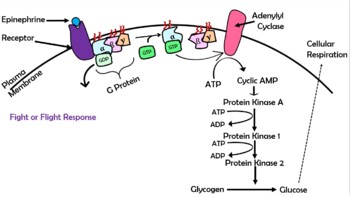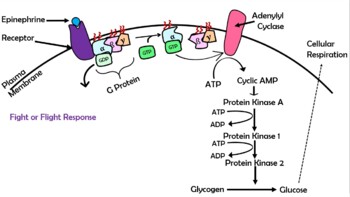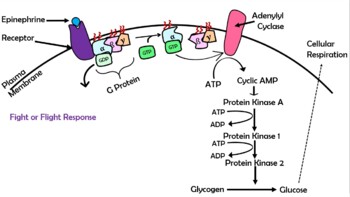Unit 4: Cell Communication and Cell Cycle Study Guide AP BIOLOGY
1/45
Earn XP
Description and Tags
Essential vocabulary and essential topic focuses, also be able to read and understand a pathway diagram
Name | Mastery | Learn | Test | Matching | Spaced |
|---|
No study sessions yet.
46 Terms

(a) Describe the role of epinephrine in initiating the signal transduction pathway shown in the diagram.
(b) Explain how the activation of the G protein leads to the production of cyclic AMP (cAMP).
(c) Discuss how the phosphorylation cascade shown in the diagram amplifies the cellular response.
(a) Role of Epinephrine – Epinephrine binds to the receptor on the plasma membrane, initiating the signal transduction pathway. This is the first step in activating the "fight or flight" response. (1 point)
(b) G Protein Activation & cAMP Production – When epinephrine binds to the receptor, the receptor activates the G protein by exchanging GDP for GTP. The activated G protein then stimulates adenylyl cyclase, which converts ATP into cyclic AMP (cAMP), a second messenger. (1 point)
(c) Phosphorylation Cascade & Amplification – cAMP activates protein kinase A, which phosphorylates other kinases in a cascade. Each kinase in the cascade activates multiple downstream proteins, amplifying the response so that a small initial signal leads to a large-scale cellular effect. (1 point)

(a) Identify the second messenger in this pathway and explain its role in signal amplification. (1 point)
(b) Predict how a mutation that prevents the G protein from hydrolyzing GTP to GDP would affect the pathway. (1 point)
(c) Explain one potential mechanism by which this pathway could be downregulated after the fight-or-flight response is no longer needed. (1 point)
(d) Describe how this signaling pathway allows for the breakdown of glycogen into glucose. (1 point)
(e) Explain how this pathway contributes to homeostasis in response to a stressor. (1 point)
(a) Second Messenger & Amplification – The second messenger is cyclic AMP (cAMP). It amplifies the signal by activating multiple protein kinase A molecules, leading to a chain reaction that results in glucose release. (1 point)
(b) Effect of G Protein Mutation – If the G protein cannot hydrolyze GTP to GDP, it will remain active, continuously stimulating adenylyl cyclase. This would lead to excessive cAMP production, overactivation of the pathway, and uncontrolled glucose release. (1 point)
(c) Pathway Downregulation – The pathway can be turned off by breaking down cAMP with phosphodiesterase, deactivating protein kinases, or removing epinephrine from the receptor via receptor endocytosis. (1 point)
(d) Glycogen Breakdown – The phosphorylation cascade activates enzymes that catalyze the breakdown of glycogen into glucose, which can then be used for ATP production in cellular respiration. (1 point)
(e) Homeostasis & Stress Response – This pathway helps maintain homeostasis by ensuring energy is rapidly available during stressful situations. Once the stressor is gone, the body returns to normal energy storage. (1 point)

A researcher is studying the effects of different inhibitors on this signal transduction pathway. They apply an inhibitor that blocks the activity of adenylyl cyclase.
(a) Predict how this inhibitor would affect the production of cAMP and downstream signaling. (1 point)
(b) Describe an experimental setup to test the effect of this inhibitor on glucose production. (2 points)
(c) Identify an alternative step in the pathway where an inhibitor could be applied to achieve a similar effect and justify your choice. (2 points)
(d) Explain how a researcher could determine whether the inhibitor's effects are reversible. (1 point)
(a) Effect of Adenylyl Cyclase Inhibitor – Blocking adenylyl cyclase prevents ATP from being converted into cAMP, which stops activation of protein kinase A and prevents glycogen breakdown into glucose. (1 point)
(b) Experimental Setup –
Treat one group of cells with epinephrine and another group with epinephrine + the inhibitor.
Measure glucose concentration in both groups.
If the inhibitor is effective, the glucose levels in the inhibitor-treated group should be lower than in the epinephrine-only group. (2 points)
(c) Alternative Inhibition & Justification – An inhibitor could also target protein kinase A. This would prevent the phosphorylation cascade from occurring, stopping glycogen breakdown. This is an effective target because it acts immediately downstream of cAMP. (2 points)
(d) Reversibility of Inhibition – To test reversibility, wash the inhibitor-treated cells and expose them to epinephrine again. If glucose production resumes, the inhibitor's effects were reversible. (1 point)